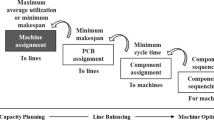Abstract
This paper focuses on developing an integrated model using simulation to evaluate the effect of several independent variables on the performance of a surface mount technology (SMT) production line. Real data and an existing SMT line from a high product mix/low volume electronics manufacturer are used to conduct the analysis. The independent variables used are set-up formation policies (group technology based family grouping methods), machine feeder types, similarity factor in set-up formation, parts reduction at design step of products, and inter-families and intra-family scheduling rules. In addition, a new method of grouping products is proposed. The measures of performance evaluated by the model are average lead time, average work-in-process (WIP) inventory and average set-up time. Data analysis shows that the proposed method of grouping products will reduce set-up time and lead time while slightly increasing WIP. The proposed simulation model helps assess the effects of some of the independent variables on line performance. Recommendations are made in order to help the user choose the best alternative to improve production line productivity and flexibility.
Similar content being viewed by others
References
Abdulnour G, Dudek RA, Smith ML (1995) Effect of maintenance policies on the just-in-time production system. International Journal of Production Research 33(2):565–583
Barena A, Sipper D (1993) Set-up reduction in PCB automated assembly. Computer Integrated Manufacturing Systems 6(1):18–26
Bhaskar G, Narendran TT (1996) Grouping PCBs for set-up reduction: a maximum spanning tree approach. International Journal of Production Research 34(3):621–632
Bombardier Sea-Doo/Ski-Doo Chair (1994), JIT Guide Self Test Working document. Institut de recherche en PME, Université du Québec à Trois-Rivières
Carmon TF, Maimon OZ, Dar-El EM (1989) Group set-up for printed circuit board assembly. International Journal of Production Research 27(10):1795–1810
Drolet J, Abdulnour G, Rheault M (1996) The Cellular Manufacturing Evolution. Computers and Industrial Engineering 31(1/2):139–142
Fisher D (1995) The just-in-time self test. Irwin Professional Publicizing, Chicago, IL
Fathi Y, Taheri J (1989) A mathematical model for loading the sequencers in a printed circuit pack manufacturing environment. International Journal of Production Research 27(8):1305–1316
Frazier GV (1996) An evaluation of group scheduling heuristics in a flow-line manufacturing cell. International Journal of Production Research 34(4):959–979
Gerwin Donald (1982) Do’s and don’ts of computerized manufacturing. Harvard Business Review 66(2):107–116
Hashiba S, Chang TC (1991) PCB assembly setup reduction using group technology. Computers and Industrial Engineering 21(1–4):453–457
Leon VJ, Peters BA (1998) A comparison of setup strategies for printed circuit board assembly. Computers and Industrial Engineering 34(1):219–234
Luzzato D, Perona M (1993) Cell formation in PCB assembly based on production quantitative data. Europian Journal of Operational Research 69(3):312–329
Maimon O, Dar-El EM, Carmon, TF (1993) Set-up saving schemes for printed circuit board assembly. Europian Journal of Operational Research 70(2):177–190
Maimon O, Shtub A (1991) Grouping methods for printed circuit board assembly. International Journal of Production Research 29(7):1379–1390
McGinnis LF, Ammons JC, Carlyle M, Crammer L, Depuy GW, Ellis KP, Tovey CA, Xu H (1992) Automated process planning for printed circuit card assembly. IIE Transactions 24(4):18–30
Montgomery D (2001) Design and analysis of experiments, 5th Edition, John Wiley & Sons Inc, New York, NY
Moyer LK, Gupta SM (1996) Simultaneous component sequencing and feeder assignment for high speed chip shooter machines. Journal of Electronic Manufacturing 6(4):271–305
Newbury P (1990) Surface mount assembly machines. Electronic Manufacturing and Production 38–39
Peters BA, Subramanian GS (1996) Analysis of partial setup strategies for solving the operational planning problem in parallel machine electronic assembly systems. International Journal of Production Research 34(4):999–1021
Randhawa S, McDowell E, Faruqui SD (1985) An integer programming application to solve sequencer mix problems in printed circuit board production. International Journal of Production Research 23(3):543–552
Rajagopalan R, Batra JL (1975) Design of cellular production systems: A graph-theoretic approach. International Journal of Production Research 13(2):567–579
Reddy V, Narendran TT (2003) Heuristics for scheduling sequence-dependent set-up jobs in flow line cells. International Journal of Production Research 41(1):193–206
Sadiq M, Landers L, Don Taylors G (1993) A heuristic algorithm for minimizing total production time for a sequence of jobs on a surface mount placement machine. International Journal of Production Research 31(6):1327–1341
Smed J, Salonen K, Johnsson M, Johtela T, Nevalainen OS (2003) Grouping PCBs with minimum feeder changes. International Journal of Flexible Manufacturing Systems 15(1):19–35
Shtub A, Maimon O (1992) Role of similarity measures in PCB grouping procedures. International Journal of Production Research 30(5):973–983
Stecke KE, Ramon N (1995) FMS planning decisions, operating flexibilities, and system performance. IEEE Transactions in Engineering and Management 42(1):82–90
Sule D (1992) A heuristic procedure for component scheduling in printed circuit pack sequencers. International Journal of Production Research 30(5):1191–1208
Author information
Authors and Affiliations
Rights and permissions
About this article
Cite this article
Lambert, S., Abdulnour, G., Drolet, J. et al. Flexibility analysis of a surface mount technology electronic assembly plant: An integrated model using simulation. Int J Flex Manuf Syst 17, 151–167 (2005). https://doi.org/10.1007/s10696-006-8125-y
Received:
Revised:
Accepted:
Issue Date:
DOI: https://doi.org/10.1007/s10696-006-8125-y




